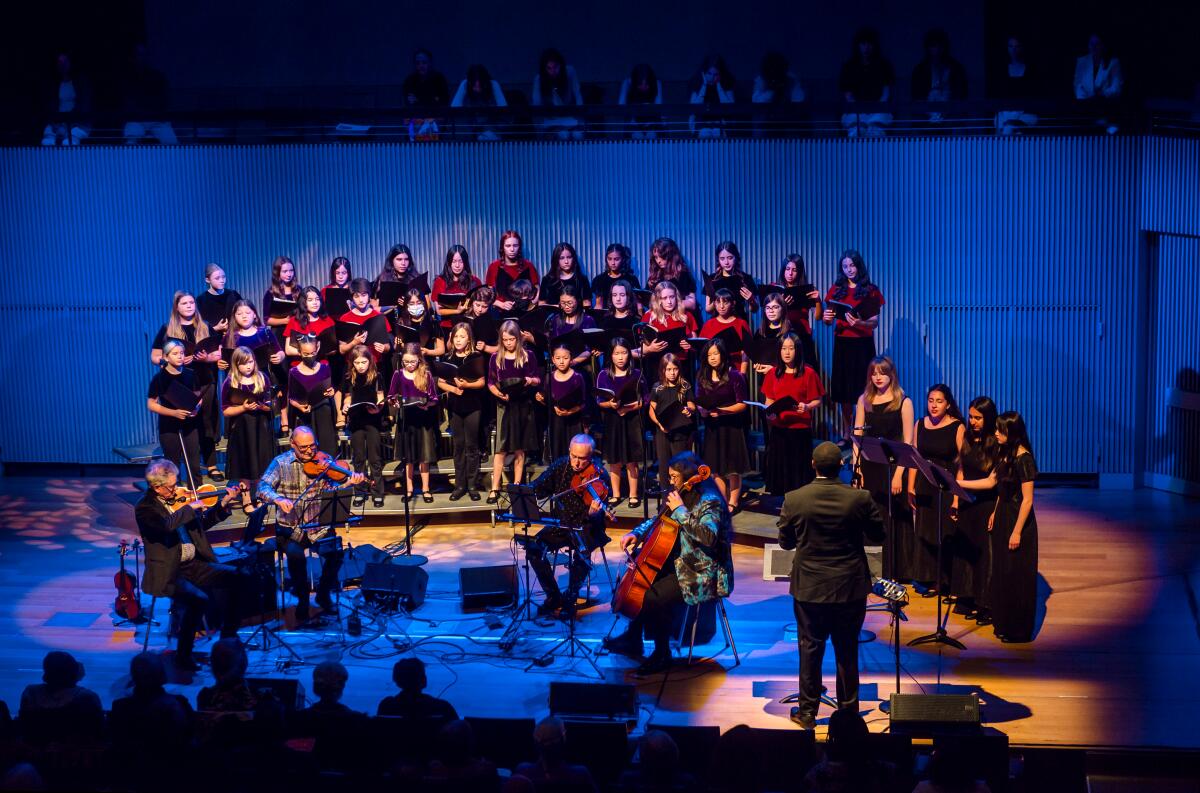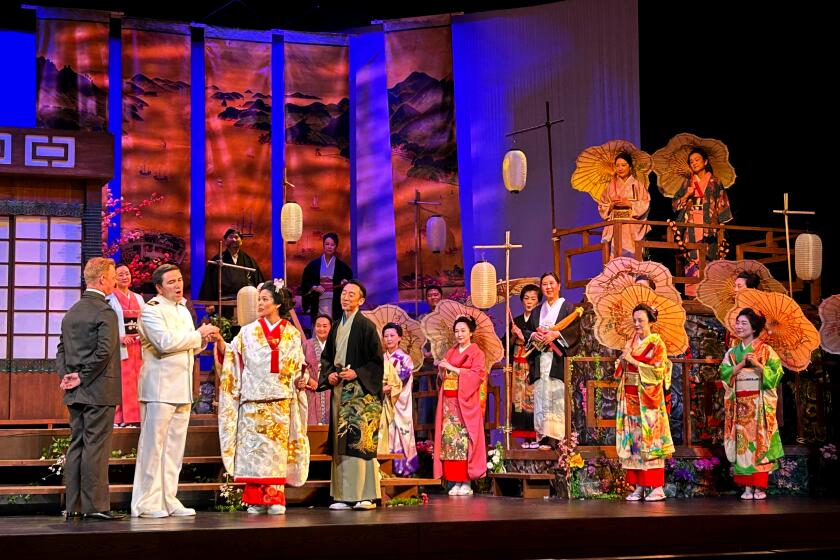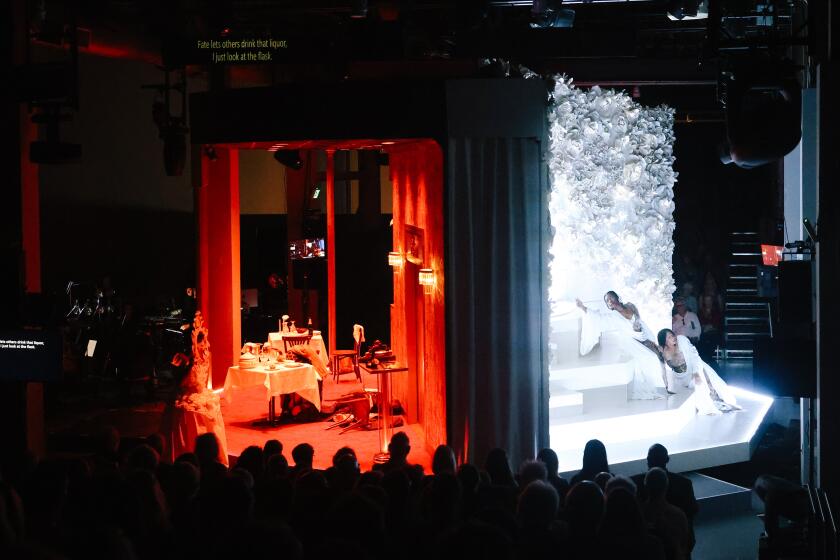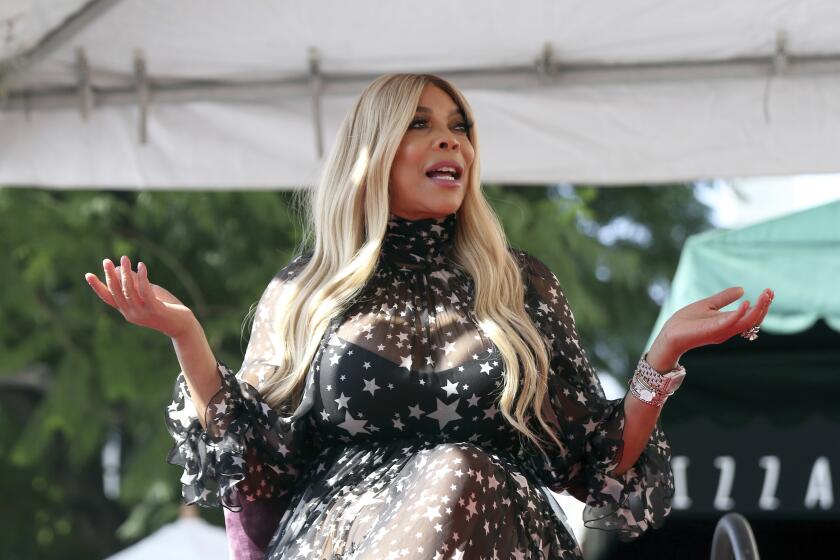Big changes afoot at 3 great San Francisco classical music institutions

- Share via
The weather was a pleasure. While much of the rest of the country roasted, San Francisco last weekend appeared a beatific city lorded over by mild yet sunny cerulean skies and ideally chilly nights.
Civic Center and the adjacent Hayes Valley neighborhood offered their own musical gratifications. June is a special month for the San Francisco Symphony, whose music director is allowed to indulge his passions. San Francisco Opera boasts a June festival of three operas, and the incomparable Kronos Quartet mounts its own festival.
Symphony, opera and Kronos were all marvelous. Esa-Pekka Salonen conducted an exalted performance of Bruckner’s Fourth Symphony in Louise M. Davies Symphony Hall, the orchestra brass as golden as a certain nearby bridge. Next door at the War Memorial Opera House, a gripping performance introduced America to Kaija Saariaho’s opera “Innocence,” a shocking drama of gun violence. A couple of blocks away at SF Jazz, Kronos celebrated its 50th anniversary, reminding us that this ensemble has changed music like no other.
All venues were full. All audiences I joined were infectiously rapt. All three institutions, it might be added, still provided large glossy program books with extensive notes, something nearly extinct in the rest of the country.
Yet everywhere I went there was an inescapable feeling of doom, of disquieting calm before the storm. Lovely days now, but summer forebodes fires. Apparent urban bliss camouflages San Francisco’s seemingly insoluble urban ills.
As I headed into Davies Hall for the Sunday matinee, I was greeted by a longtime member of the orchestra handing out yellow fliers on which was a message from the musicians to patrons. “The board is trying to turn us into a regional orchestra,” the bass player angrily announced.
The opera world is turning its attention to L.A. with World Opera Forum and Opera America conferences, but they’re missing much of the city’s best work.
The symphony is indeed in a state of turmoil that feels existential. Four years ago, Salonen became music director with the mandate to foster innovation, following what he had accomplished in his 17 years at the helm of the Los Angeles Philharmonic.
Unfortunately, the city and its orchestra were hard hit by the pandemic. Rather than give Salonen the support to realize his bold vision, the San Francisco Symphony, which sits on a $345-million endowment (the second largest of any American orchestra), slashed, slashed and slashed some more. Management insists the institution will otherwise run out of cash. Dire financial projections have become self-fulfilling prophecy.
Salonen has refused to renew his contract (which runs for one more season) after the board scaled back a European tour, new commissions, innovative programming and staged productions with Peter Sellars, its much-heralded digital media, its “Concerts for Kids” series and the far-reaching creative partners from various walks of music and technology Salonen appointed. A black-box series, SoundBox, a hit with young audiences, has been downgraded as well. Frank Gehry’s proposals for inexpensive experimental new halls made by refashioning warehouses on Treasure Island should be a no-brainer, but for this board they are a nonstarter. A musicians strike looks likely in the fall.
Still, one ironic outcome from these troubles is an orchestra hell-bent on proving its worth. There was in its performance Sunday — which opened with a wondrous performance of Schumann’s Piano Concerto and soloist Yefim Bronfman — unrelenting intensity. Meanwhile, Bruckner’s brazen rhythmic patterns in his “Romantic” symphony sounded like bodacious calls for change and expletives against the board. In the composer’s grand lyrical phrases, the orchestra seemed to say, with profound expression, Read our collective hearts.

The atmosphere at San Francisco Opera feels to an outsider more accepting than bellicose. But it, too, has instituted large cutbacks. Facing rising costs in producing opera, it will reduce the number of operas performed from eight to six next season. That’s a third the number the company once presented. The big difference between this company and the orchestra, however, is that the will to continue its mission appears unchanged, and new ways are being explored to pay for it.
I met with Matthew Shilvock, the company’s general director and a trained musicologist. He says costs are rising so rapidly that every year an additional $2 million to $3 million is needed for even this modest number of productions.
Shilvock’s strategy is to productively tap into the kind of crisis intensity felt by his neighboring symphony. Every production, every performance needs to matter. That includes continuing to present new and challenging work.
Yuval Sharon’s ‘The Comet / Poppea’ is as an experimental dialogue with history in a way that only opera, with its capacity to worm its way inside the minds of characters, might attempt.
“Innocence,” which has been a hit, gives him confidence that this is the right approach. The opera, which had its premiere in Aix-en-Provence, France, in 2021, was the last for Saariaho, who died a year ago. It is also a change of direction from her earlier profoundly philosophical and poetic pieces, all done in collaboration with Sellars.
There is little of that poetry or profundity here; “Innocence” is more akin to a Netflix drama. Ten years after a school shooting in which 10 students and their teacher were killed, the mother of one of the victims and the young shooter confront each other at a party. The students are ghosts, actors with speaking roles. There are strange and startling twists of plot keeping the audience in suspense.
The issue of gun violence was presented with complexity. The fashionable production by Simon Stone is cleverly devised on a revolving stage. The large cast of singing actors proved uniformly excellent Friday night, the last of the six performances. The enthusiastic conductor, Clément Mao-Takacs, could be overly flashy, but the real glory in the opera, its saving grace in many ways, was the exceptional beauty and expression of Saariaho’s orchestral writing, and this came through spectacularly well.
Under a surface of undulating sonic beauty, the roots of the shattering elements in “Innocence” can be found in Saariaho’s 1987 “Nymphéa” for string quartet and electronics. That happens to be one of more than 1,000 string quartets Kronos has commissioned over the last half century. Thanks to Kronos, Steve Reich, Terry Riley, Philip Glass and many of the great names of the 20th and 21st centuries — along with composers in rock, jazz, country, folk, raga, Chinese pipa music and other global traditions from every continent — turned to this unlikely medium.

No ensemble in the history of music has come close to doing so much, and a four-night festival can’t come close to exhibiting it. So with but a little looking back, Kronos did what it always does: look ahead, performing new music.
Saturday night, the first of the two programs I heard, was the premiere of Mary Kouyoumdjian’s spiritually spellbound “The Space Between.” There was a movement from Riley’s new, otherworldly “This Assortment of Atoms — One Time Only!” This is one of the Kronos Quartet’s “50 for the Future” commissions from composers, Glass and Laurie Anderson among them, producing works suitable for young string quartets. All the scores are made available for free on the Kronos website, and more than 38,000 scores have been downloaded in 108 countries and territories.
The concert also included two feisty new works by teenage composers Hannah Wolkowitz and Ilaria Hawley. The San Francisco Girls Chorus joined Kronos for works by the likes of Yoko Ono, Pete Seeger and Mali singer Hawa Kassé Mady Diabaté. At the end, the guest was Iranian singer Mahsa Vahdat.
The festival ended Sunday with Sam Green’s live Kronos documentary film “A Thousand Thoughts,” which includes live performances by the Kronos. This was the 46th and last time the film will be shown. Two key members of the quartet from the last four-plus decades, violinist John Sherba and Hank Dutt, are retiring. It was a bittersweet, deeply moving and loving finale.
What will happen next to the Kronos? The ensemble also is losing its first and only manager, Janet Cowperthwaite, who behind the scenes made the commissions and all else possible. First violinist David Harrington, the quartet’s visionary founder, will soldier on with cellist Paul Wiancko and two new young players, violinist Gabriela Díaz and violist Ayane Kozasa.
An era has ended. But Harrington is the most optimistic musician I know. His record of accomplishing the unthinkable has made him an unerring San Francisco symbol for the future.
It would be a poor investment not to bet on Kronos. Harrington has made the impossible happen not by cutting back but by tirelessly seeking more. He has gained international support by not letting anything stop him.
The San Francisco Symphony and San Francisco Opera could do the same by believing in the future, beginning with digging into the damn endowments. The city, too, could (and typically does) do worse than following Kronos’ extraordinary belief in the possible. We all could. The model exists.
More to Read
The biggest entertainment stories
Get our big stories about Hollywood, film, television, music, arts, culture and more right in your inbox as soon as they publish.
You may occasionally receive promotional content from the Los Angeles Times.












